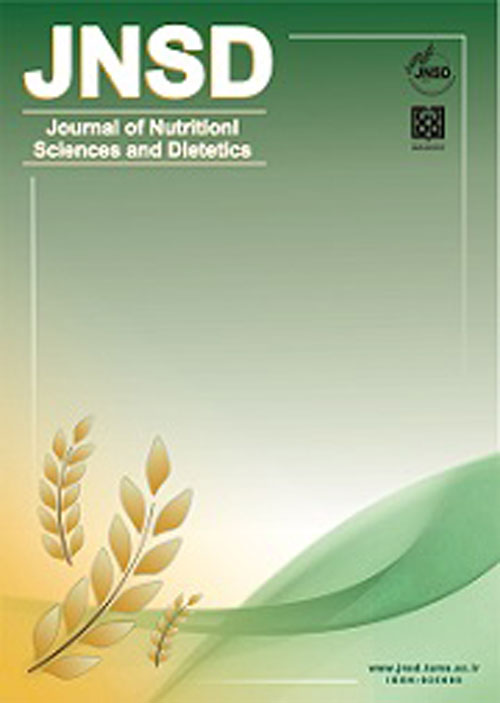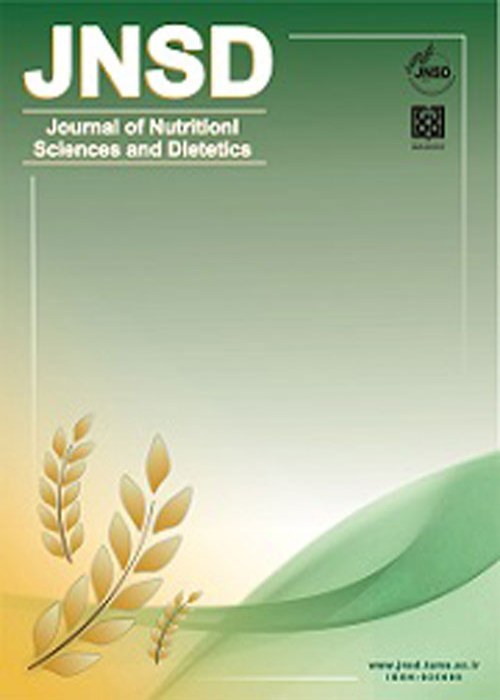فهرست مطالب

Journal of Nutritional Sciences and Dietetics
Volume:2 Issue: 2, Spring 2016
- تاریخ انتشار: 1395/09/15
- تعداد عناوین: 8
-
-
Pages 3-10Background /ObjectiveAs the global elderly population increases,the prevalence of osteoporosis and the incidence of osteoporosis-related fractures are becoming a major social and medical concern in both developed and developing countries. Therefore, the objective of the present study was to examine association dietary pattern and bone health in postmenopausal women.Materials And MethodsIn this study, 254 postmenopausal women aged 46 to 78 years were examined. Body composition measured by Body Composition Analyzer Physical activity using the short form of physical activity questionnaire (IPAQ) was performed Bone mineral density was measured by DEXA method. Major dietary patterns were determined using factor analysis on 27 foods groups using a valid and reliable, 147-item semi-quantitative food frequency questionnaire (FFQ) The major dietary patterns were identified by factor analysis (PCA) method.ResultsThree dietary patterns including The Mediterranean diet, Traditional and unhealthy were identified. These three dietary patterns explained 30.45 % of total variance in dietary intakes. Our results showed that higher adherence score to a " Mediterranean " dietary pattern was positively associated with Zscore L2_L4 lumbar spine (0.05> P). Furthermore, logistic regression results showed that Mediterranean dietary pattern reduces the risk of osteopenia/ osteoporosis (OR = 0.75, 95%CI: 0.58 -0.96). However, Traditional (OR = 0.97, 95%CI: 0.76 -1.24) and Unhealthy (OR = 1.19, 95%CI: 0.93 -1.52) dietary patterns were no association with risk of osteopenia/ osteoporosisConclusionIt seems Mediterranean dietary pattern, has a protective association against the risk of osteopenia/ osteoporosis in postmenopausal women.Keywords: Bone mineral density, Dietary patterns, postmenopauasl women, Mediterranean diet, osteoporosis
-
Pages 11-20BackgroundSome food patterns and lifestyles have beneficial effects on diminution of metabolic syndrome (MetS) components. Alternate Mediterranean Diet (aMED) because of its contents may have potential protective impacts against the risk of developing the metabolic syndrome in elderly people.ObjectiveWe assessed the association between alternate Mediterranean Diet (aMED) and metabolic syndrome components in Iranian elderly.Method226 healthy elderly people (65 men and 161 women) with a mean age of 67.04 years participated in this cross-sectional study in five districts of Tehran, the capital of Iran during the period 20014-20015. MetS was defined based on the National Chol esterol Education Program Adult Treatment Panel III criteria. Dietary intakes were assessed using a validated food frequency questionnaire (FFQ) that included 147 items. The Alternate Mediterranean dietary score was calculated by Fung et al. Method. Logistic and linear regression models were used to derive beta estimates and odds ratios (ORs).ResultsSubjects in the top tertile of Alternate Mediterranean diet had 56% lower chance of metabolic syndrome compared with subjects in the bottom tertile (OR 0·46; 95% CI 0·23, 0·94; P trend=0.033 ). After adjustment for potential confounders such as age, energy intake, physical activity, marital status, smoking, education, income this association was strengthened (OR 0·34; 95% CI 0·14, 0·82; P trend=0.017).Also it was observed that people in the highest tertile of the Alternate Mediterranean diet score had 68% lower odds of high triglycerides compared with those in the lowest tertile (OR 0·42; 95% CI 0·20, 0·91; P trend=0.033).ConclusionOur study showed a higher adherence to the alternate Mediterranean diet reduced the risk of the metabolic syndrome in the elderly subjects.Keywords: Alternate Mediterranean diet, Metabolic syndrome
-
Pages 20-24Backgroundlack of breastfeeding initiation in the first hours after birth is an influencing factor in the incidence of jaundice, and breastfeeding problems in the first week of birth are common. Given the effectiveness of oral carbohydrate before the cesarean section on maternal breastfeeding in the first days of birth, this study was conducted to investigate the effectiveness of oral carbohydrate on the incidence of neonatal jaundice.MethodsIn this randomized, double-blind clinical trial study, a total of 91 women scheduled for elective cesarean surgery were randomly divided into intervention (oral carbohydrate before surgery, N=45) and placebo (flavored water before surgery, N=46) groups. The intervention group received 400 800 ml of a carbohydrate solution before surgery. Until the end of the first week of birth, subjects were followed-up for neonatal jaundice incidence through the information contained in the medical records.ResultsIn the intervention group, 6 infants developed jaundice. All these cases were infants with blood group of A or B from mothers with blood group of O. In contrast, in the placebo group, 25 infants developed jaundice, of them, 5 cases were infants with blood group of A or B from mothers with blood group of O. The number of infants with jaundice was significantly lower in the group receiving oral carbohydrate than in the group receiving placebo (n = 25 (54.3%) VS. n = 6 (13.3%), P 0.001).ConclusionRegardless of the type of blood group, pre-cesarean oral carbohydrate intake was observed to reduce the incidence of neonatal jaundice. These findings suggest that carbohydrate could be used as a preventive dietary supplement against neonatal jaundice, which occurs due to the lack of breastfeeding. However, further clinical trials are warranted to confirm our results and to investigate the role of other influencing factors on jaundice such as G6PD deficiency status.Keywords: neonatal jaundice, cesarean surgery, oral carbohydrate, breastfeeding
-
Pages 25-33ObjectiveThis study attempted to investigate acute effect of strenuous physical activity with & without saffron supplementation on heat shock protein 70 (HSP70), interleukin-6 (IL-6) and TNFα in male mountain climbers
Design: A 10-day, one-blind, pretestposttest design.
subjects: Eleven male climbers with an age range of 27-37 years old ran at one session physical activity with intensity 80-90% of maximum heart rate for 45 minutes on a -5% slope surface. Blood samples were collected from subjects before, immediately and after one hour the physical activity to measure HSP70, IL-6 and TNFα. 3 days after recovery, the subjects were given 300 mg of dried stigmas of saffron in capsules once a day for ten days. Subsequently, blood samples were obtained from the subjects again before, immediately and after one hour physical activity. The changing trends in the variables were evaluated through analysis of variance with repeated measures at a significance level 0.05.Resultsone session strenuous physical activity with saffron supplementation compared with only physical activity had a significant effect on the level of heat shock protein 70 (680.25±127.86 528.18±111.63) at the immediately after of physical activity(P0.05)Conclusionssaffron intake ten days before a session of strenuous physical activity can have decrease effect on heat shock protein 70 immediately after physical activity.Keywords: saffron, HSP70, IL-6, TNFα, strenuous physical activity -
Pages 40-47ObjectiveThe possible role of vitamin D receptor (VDR) variants in determining cardiovascular risk factors has been suggested previously. The purpose of the present study was to evaluate the associations of variants of vitamin D receptor (VDR) gene with metabolic profile in Iranian overweight women with hypovitaminosis D.Materials And MethodsVariants in VDR gene including FokI (rs2228570), BsmI (rs1544410) and rs757343 were detected using PCR-sequencing. Metabolic Profile including fasting plasma glucose, total cholesterol, LDL-C, HDL-C, and triacylglycerol was assessed using commercial kits. Circulating 25 (OH) D was measured using ELISA kits. Fat mass and visceral fat were measured using Bio Impedance Analysis.ResultsA sample of 123 overweight women with hypovitaminosis D (25 (OH) D0.05). Also, adiposity phenotype measures were not significantly different in the genotype groups of the studied SNPs (p>0.5).ConclusionsThe present results indicate that the FokI polymorphism is significantly associated with total cholesterol and LDL-C in Iranian overweight women with hypovitaminosis D.Keywords: Hypovitaminosis D, Metabolic profile, Total cholesterol, LDL-C, VDR variants, Overweight
-
Pages 48-57Retinol (ROH) and its derivatives named vitamin A are substantial for several cells functions. Retinol Binding Protein 4 (RBP4) is known as the career for vitamin A in blood. The main receptor for RBP4 is Stimulated by retinoid acid gene 6 (STRA6). RBP4 circulates in bound with Transports Thyroxine and Retinol (TTR) to form ternary ROH-RBP-TTR complex. Recently, RBP4 implicated in insulin resistance which may exerts its functions through inflammatory pathways. Although studies indicated that RBP4 may have role in inflammation as an adipocytokine. the cellular and molecular mechanisms including the interaction between Holo- or Apo-RBP4 and their receptor to induce inflammation is controversial. In this review, we focus on molecular structure of RBP4, STRA6, and their interaction to induce inflammation and insulin resistance to illustrate the potential conflicts in this area.Keywords: Retinol binding protein 4, RBP4, Retinol, insulin resistance, STRA6, Inflammation, transthyretin
-
Pages 50-51Eating a healthy, balanced diet is essential for athletes to meet their needs for essential nutrients in order to promote optimal health, reach peak performance, build strength and/or muscle mass, as well as prevent injury and help rapid recovery from injury. There is widespread recognition today that most athletes have moved on from the typical concepts of nutrient deficiencies and plain nutritional adequacy to positive or optimal performance in sport (1).
Dietary supplements are used by many athletes to improve their performance beyond what can be achieved through a typical nutritionally balanced diet. Consequently, the growing interest in nutraceuticals/functional foods/dietary supplements has led to an important paradigm shift in the field of supplements and sport nutrition (2). Functional foods and/or nutraceuticals are new terms used in the food and nutrition sciences. Generally, most foods are considered functional since they have a certain taste, aroma, and/or nutritive value. However, the formal definition of functional foods by the Institute of Medicines Food and Nutrition Board (3) is any food or food ingredient that may provide a health benefit beyond the traditional nutrients it contains. Functional foods are foods that are intended to be consumed as part of the normal diet and offer the potential to optimize physical and mental well-being or reduce risk of disease due to certain specific physiologically active components. Examples of such foods include foods containing probiotics, prebiotics, or plant stanols and sterols, as well as foods or drinks with added biologically active substances such as phytochemicals, antioxidants or nutrients.
Due to increased awareness about potential health benefits of myriads of functional foods and nutraceuticals there is a growing demand among athletes for these products. On the sports market several functional food products are sold but the efficacy of only a few of them has been clearly demonstrated to justify their recommendation for improving sport performance. Furthermore, although a large number of studies have reported the beneficial effects of functional foods in human health (4), very limited data are available on their use in different sports. In future research serious attempts should be made to establish evidence-based guidelines for the use of sport-specific functional foods to improve energy metabolism, hormone release and muscle function; help maintain fluid balance; reduce muscle cramps/pain; and help rapid recovery from injury.
In addition, using valid methods, potential risks related to the safety of individual functional foods need to be assessed. Due to lack of regulations for the use of functional foods in most countries, the performance-enhancing claims made for these products may be false or misleading. Government regulatory bodies, as well as professional sport organizations and academia, face challenges in this important field and must establish specific legal and scientific criteria for the use and evaluation of athletic functional foods.Keywords: Functional foods, Physical activity, Healthy eating


